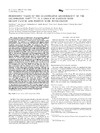Identificador persistente para citar o vincular este elemento:
https://accedacris.ulpgc.es/jspui/handle/10553/42586
| Título: | Prognostic value of the quantitative measurement of the oncoprotein p185(Her-2/neu) in a group of patients with breast cancer and positive node involvement | Autores/as: | Bohn, Uriel Aguiar, José Bilbao Sieyro, Cristina Murias, Adolfo Vega, Victor Chirino Godoy, Ricardo Díaz-Chico, Nicolas Díaz Chico, Juan Carlos |
Clasificación UNESCO: | 320101 Oncología | Palabras clave: | Breast cancer p185 oncoprotein ELISA Her-2 Neu Oncogene C-Erbb-2 Expression, et al. |
Fecha de publicación: | 2002 | Editor/a: | 0020-7136 | Publicación seriada: | International Journal of Cancer | Resumen: | Our study attempts to determine the prognostic value of the quantitative measurement of the oncoprotein p185Her‐2/neu in a group of patients with breast cancer and positive node involvement. In a series of 217 patients with breast cancer and positive nodes in whom the oncoprotein p185 was quantitatively determined by ELISA, we analyzed the clinico‐pathological variables including age, menopausal status, tumor size, number of affected nodes, type and histology grade and the molecular variables such as the oestrogen and progesterone receptors (ER and PR, respectively), pS2 and Cathepsin D (CD). Using 260 fmol/mg protein as a cut‐off point, 18% of the tumors presented as overexpressing p185. The p185 showed no relationship with any of the clinico‐pathological variables studied except that its concentration was elevated in ductal and lobular histology types and in the moderate and poorly differentiated histology grades. With a median follow‐up of 50 months (range 1–90), the univariate analysis of disease‐free survival (DFS) and overall survival (OS) showed that the histology grade, tumor size, the number of infiltrated nodes, the p185 and the ER were the variables associated with the clinical course of the disease in the patients. In the multivariate analysis, however, only the tumor size, number of affected ganglia, the p185 and the ER remained associated with the clinical progression of the disease. The patients with p185 overexpression had a risk, not only of relapse but also death from the disease, of more than twice that of the patients who had normal p185 concentrations. When the p185 was divided into 3 categories based on ±1 × SD above or below the mean, the patients with high and low p185 showed, in the univariate analysis, a similar relationship with DFS but not with OS. In the multivariate analysis, both with the DFS as with the OS, only a high p185 concentration retained its association with the clinical course of the disease in the patients. Our results suggest that by quantitatively determining (using ELISA) the p185 oncoprotein, groups of cancer patients of high risk could be better identified for more effective clinical management. | URI: | https://accedacris.ulpgc.es/handle/10553/42586 | ISSN: | 0020-7136 | DOI: | 10.1002/ijc.10612 | Fuente: | International Journal Of Cancer [ISSN 0020-7136],v. 101 (6), p. 539-544 |
| Colección: | Artículos |
Citas SCOPUSTM
7
actualizado el 08-jun-2025
Citas de WEB OF SCIENCETM
Citations
7
actualizado el 08-jun-2025
Visitas
125
actualizado el 17-may-2025
Descargas
169
actualizado el 17-may-2025
Google ScholarTM
Verifica
Altmetric
Comparte
Exporta metadatos
Los elementos en ULPGC accedaCRIS están protegidos por derechos de autor con todos los derechos reservados, a menos que se indique lo contrario.
